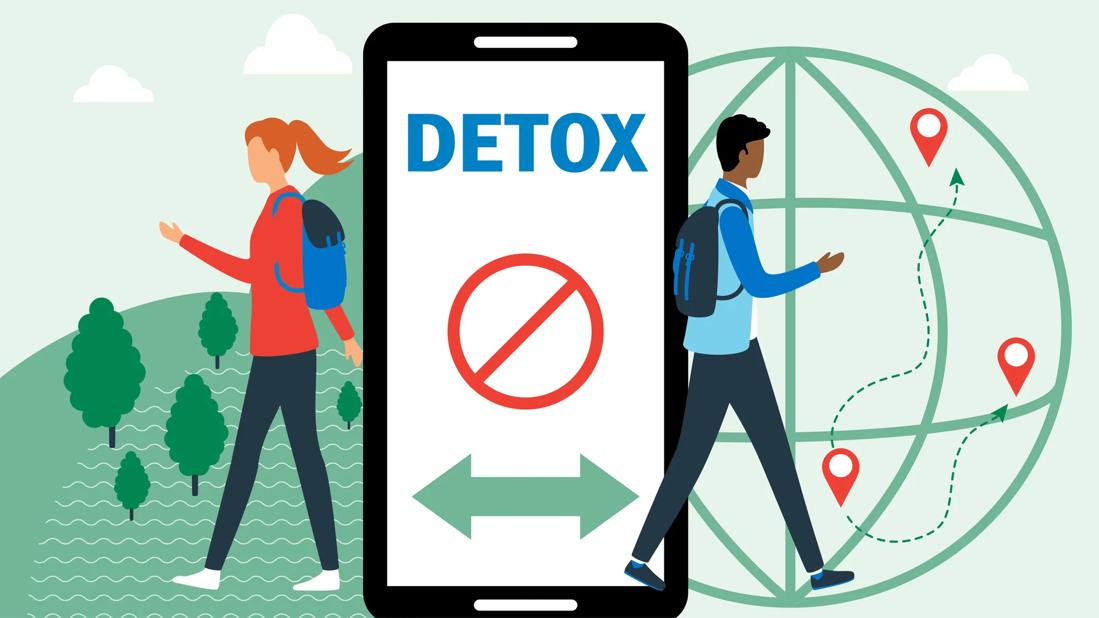Instead of trying to get rid of dopamine, focus on stepping away from habits and behaviors that no longer serve you

Once in a while, a wellness trend comes along that sounds too good to be true. It’s so quick, so easy and so life-changing, everyone should do it!
Advertisement
Cleveland Clinic is a non-profit academic medical center. Advertising on our site helps support our mission. We do not endorse non-Cleveland Clinic products or services. Policy
Dopamine detoxes are NOT that trend. At least, not the ones you see on social media. They’re difficult and unpleasant by design. And to top it off, they don’t even work!
But is there any merit to the concept of dopamine fasting? Any way to get the miraculous health benefits you see and hear about on social media? To answer that question, we have to go back to 2019. Psychologist Susan Albers, PsyD, explains how a buzzy twist on an old psychological practice got blown out of proportion.
A psychologist named Cameron Sepah first coined the term “dopamine fasting” in a 2019 article on LinkedIn. The goal, as he described it, was to reduce problematic or impulsive behaviors like emotional eating and excessive use of the internet and social media. These and other behaviors, he explained, give us quick hits of dopamine. By abstaining from both these activities and other forms of instant gratification, the theory goes that we become less reliant on those stimuli to feel happy. He pitched it like it was a new idea, writing, “Just as intermittent fasting has become all the rage in Silicon Valley, I have created ‘Dopamine Fasting 2.0’ as the antidote to our overstimulated age.”
But here’s the thing: The only part of Dopamine Fasting 2.0 that was innovative was the name. What Sepah described as a “dopamine detox” or “dopamine fast” is actually a form of psychological conditioning that’s been around for a long time.
Advertisement
“A more appropriate or accurate term would be cognitive behavioral therapy (CBT) because what you’re doing is changing a habit or a behavior using mindfulness techniques,” Dr. Albers explains. “It’s teaching yourself — usually with a therapist’s help — to be comfortable with uncomfortable feelings. To stop turning to something pleasurable to distract from difficult emotions or thoughts.”
So, where does dopamine fit into the equation, exactly? Well, that’s part of the problem. It doesn’t because the term “dopamine detox” describes something that isn’t humanly possible.
Sepah himself admitted that it’s just a catchy title and shouldn’t be taken literally. But the concept of dopamine fasting took off on social media, and the unscientific name allowed it to morph into something else. Instead of being a repackaged, trendy version of cognitive behavioral therapy, it became an unscientific wellness fad.
Instead of trying to reduce or eliminate one or two problematic behaviors, most people now use the term “dopamine detox” to describe abstaining from anything and everything they find pleasurable, to the extent that that’s possible.
Most advocates of dopamine fasting think they’re reducing the levels of that specific neurotransmitter in their body, which they (incorrectly) believe is a good thing. They believe that too much dopamine makes life less enjoyable. By setting aside pleasurable behaviors, their logic goes that you reduce your “dopamine tolerance,” so you don’t need to be overstimulated all the time to be satisfied with your life.
Dr. Albers breaks down all the different problems with that theory.
There is no such thing as a true dopamine detox. And that’s a good thing! We need dopamine to live.
Let’s back up a bit and explain what exactly dopamine is. Dopamine is a neurotransmitter and hormone that our brains naturally produce. It’s not a toxin. Our brain uses dopamine as a messenger, sending signals throughout the body that allow it to function.
“We need dopamine in every system in our body — to move, to sleep, to experience pleasure. So, it’s a critical component that we can’t and don't want to get rid of,” Dr. Albers explains.
In fact, having low dopamine levels causes a variety of health issues, from chronic constipation to memory issues. It’s also a hallmark of Parkinson’s disease, depression, restless leg syndrome and attention-deficit/hyperactivity disorder.
Another thing about dopamine: It isn’t the only neurotransmitter that makes you feel good when you engage in pleasurable activities. Endorphins, serotonin, oxytocin and norepinephrine are just a few of the “happy hormones” involved. Even if it were possible to detox off dopamine — which, again, it isn’t — you wouldn’t get the desired effect.
Advertisement
“Dopamine is one part of the equation,” Dr. Albers reiterates, “but there are many different aspects involved in developing an addictive or compulsive behavior, so isolating your focus to one particular substance in the body doesn’t make sense.”
Here’s yet another problem with the concept of dopamine fasting: Positive, healthy activities release dopamine, too.
“Neurotransmitters are survival mechanisms,” Dr. Albers explains. “Without dopamine, we wouldn’t bother to do things like eat, exercise, reproduce or socialize. We wouldn’t bother because there would be no motivation. We need some pleasure in our life.”
Do compulsive behaviors release dopamine and other happy hormones? Yes. That’s what makes addiction so insidious: The same reward system that tells you to engage in healthy activities is also telling you to continue a dangerous or distressing behavior.
The idea of abstaining from any activity that brings you joy sounds … well, joyless. And it is. Sure, some people may see it as a mighty challenge. But generally speaking, that level of self-denial isn’t going to create meaningful change.
“It becomes consuming,” Dr. Albers states. “The things you lack become the focus of all your attention. Behavior change doesn’t have to be really intense and complex. And it shouldn’t involve taking away everything. In a lot of ways, that method could backfire.” It’s the same reason crash diets are ineffective: The change may be dramatic, but it’s also unsustainable.
Advertisement
You don’t change your habits by tearing your life apart — you do it by focusing on and modifying one or two problematic behaviors at a time. Which is likely what Cameron Sepah intended all along.
So, dopamine detoxes aren’t a thing. But that’s OK because CBT is a thing, and it’s helped lots of people break bad habits and curb problem behaviors. Dr. Albers breaks it down into five steps.
Step one: Decide what you’re changing
Pick a particular activity or substance, like online gaming, that you know has a bit of a hold on your life. It’s distracting, maybe even overwhelming, and you want to be done with it.
Step two: Set up the experiment
Pick the amount of time you want to spend abstaining from your chosen activity. It could be anywhere from an hour to a week to a month, depending on what you’re trying to change.
“If totally stopping the activity sounds too intense for you, create a window instead,” Dr. Albers suggests. “Maybe you only spend 20 minutes a day on social media, for example, or you can’t log on before a specific time. That might be a good baby step.”
At this stage, she recommends thinking about this exercise as an experiment: We just want to see what kind of impact this behavior change has on your emotions and brain.
Advertisement
Step three: Find a replacement activity
It’s going to be much harder to change your behavior if there isn’t an incentive. That’s why Dr. Albers recommends replacing the activity you’re abstaining from with another pleasurable activity — one that’s more soothing but still gets those happy hormones going. Instead of trawling social media, go on a walk outside. Instead of going shopping, browse the stacks at your local library.
Step four: Keep records
It’s important to take some notes or maintain a journal during this experiment.
“And pay attention to the triggers that urge you to participate in the stimulus,” Dr. Albers urges. “For example, maybe stress is a trigger that leads you to binge eat, or maybe the desire’s strongest when you’re with certain people. Notice when the desire comes and how it ebbs and flows through your day.”
She also recommends asking yourself these questions:
Writing down your observations in a journal is a helpful way to check in with yourself, assess the value of the change you’re making, and stay engaged in and mindful about the process.
Step five: Determine next steps
Once you reach the end of your experiment, it’s time to decide if it was successful. If it was, do you feel it needs to continue? If it wasn’t, what would have to change to get your desired outcome? Does it feel like something you can do on your own?
“If the habit or activity is truly an addiction, it can be difficult to unravel on your own,” Dr. Albers recognizes. “You may need the help of a therapist, an addiction counselor, a support group or a residential rehabilitation facility.”
Originally a scientifically inaccurate rebranding of cognitive behavioral therapy, social media took the concept of “dopamine detox” and ran with it, turning it into a full-blown pseudoscientific theory that misrepresents how both dopamine and the human brain work.
But Dr. Albers sees a positive side to this odd story.
“It is a very catchy term, and I hope it’s motivated a lot of people to learn about cognitive behavioral therapy,” she says. “Feeling overstimulated — particularly by social media and your phone — is a thing most of us can identify with. Maybe this trend will help more people see the value of working with a therapist or give them the confidence to make changes that feel hard.”
As long as you don’t try to cut all the joy out of your life, changing your habits is worth a shot!
Learn more about our editorial process.
Advertisement

The hallucinogenic brew has cultural and religious significance for some communities in the Amazon basin

It isn’t a recognized mental health disorder, but research shows that problematic social media use can negatively affect your mental health, self-esteem and sleep

Tart cherry juice contains natural compounds that may support better sleep

When you’re dependent on a substance, your body relies on it to function; when you’re addicted to a substance, you continue to use it despite negative consequences

A consistent exercise routine can bring you positive results from head to toe

You can release serotonin, oxytocin, dopamine and endorphins by cooking a meal, walking outside, petting your dog and more

This social media productivity hack involves carving out time every morning for self-care

Face-touching is a common habit, but one that can be overcome, like by learning to recognize when you’re doing it and keeping your hands distracted

Start having sex about 72 hours before ovulation, then at least every other day during your fertile window

Attachment theory suggests that your earliest relationships shape connections throughout your life

It isn’t a recognized mental health disorder, but research shows that problematic social media use can negatively affect your mental health, self-esteem and sleep